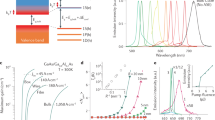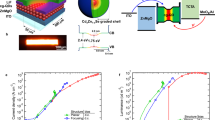Abstract
Colloidal quantum dots exhibit efficient photoluminescence with widely tunable bandgaps as a result of quantum confinement effects1. Such quantum dots are emerging as an appealing complement to epitaxial semiconductor laser materials, which are ubiquitous and technologically mature, but unable to cover the full visible spectrum (red, green and blue; RGB)2. However, the requirement for high colloidal-quantum-dot packing density, and losses due to non-radiative multiexcitonic Auger recombination, have hindered the development of lasers based on colloidal quantum dots3,4,5,6,7,8,9. Here, we engineer CdSe/ZnCdS core/shell colloidal quantum dots with aromatic ligands, which form densely packed films exhibiting optical gain across the visible spectrum with less than one exciton per colloidal quantum dot on average. This single-exciton gain allows the films to reach the threshold of amplified spontaneous emission at very low optical pump energy densities of 90 µJ cm–2, more than one order of magnitude better than previously reported values9,10,11,12. We leverage the low-threshold gain of these nanocomposite films to produce the first colloidal-quantum-dot vertical-cavity surface-emitting lasers (CQD-VCSEL). Our results represent a significant step towards full-colour single-material lasers.
This is a preview of subscription content, access via your institution
Access options
Subscribe to this journal
Receive 12 print issues and online access
$259.00 per year
only $21.58 per issue
Buy this article
- Purchase on Springer Link
- Instant access to full article PDF
Prices may be subject to local taxes which are calculated during checkout




Similar content being viewed by others
References
Brus, L. E. Electron–electron and electron–hole interactions in small semiconductor crystallites: the size dependence of the lowest excited electronic state. J. Chem. Phys. 80, 4403–4409 (1984).
Risk, W. P., Gosnell, T. R. & Nurmikko, A. V. Compact Blue-Green Lasers (Cambridge Univ. Press, 2003).
Wang, L-W., Califano, M., Zunger, A. & Franceschetti, A. Pseudopotential theory of Auger processes in CdSe quantum dots. Phys. Rev. Lett. 91, 056404 (2003).
Klimov, V. I. et al. Optical gain and stimulated emission in nanocrystal quantum dots. Science 290, 314–317 (2000).
Caruge, J. M., Chan, Y., Sundar, V., Eisler, H. J. & Bawendi, M. G. Transient photoluminescence and simultaneous amplified spontaneous emission from multiexciton states in CdSe quantum dots. Phys. Rev. B 70, 085316 (2004).
Malko, A. V. et al. From amplified spontaneous emission to microring lasing using nanocrystal quantum dot solids. Appl. Phys. Lett. 81, 1303–1305 (2002).
Fisher, B., Caruge, J-M., Chan, Y-T., Halpert, J. & Bawendi, M. G. Multiexciton fluorescence from semiconductor nanocrystals. Chem. Phys. 318, 71–81 (2005).
Mikhailovsky, A. A., Malko, A. V., Hollingsworth, J. A., Bawendi, M. G. & Klimov, V. I. Multiparticle interactions and stimulated emission in chemically synthesized quantum dots. Appl. Phys. Lett. 80, 2380–2382 (2002).
Chan, Y., Caruge, J. M., Snee, P. T. & Bawendi, M. G. Multiexcitonic two-state lasing in a CdSe nanocrystal laser. Appl. Phys. Lett. 85, 2460–2462 (2004).
Cooney, R. R., Sewall, S. L., Sagar, D. M. & Kambhampati, P. Gain control in semiconductor quantum dots via state-resolved optical pumping. Phys. Rev. Lett. 102, 127404, (2009).
Cooney, R. R., Sewall, S. L., Sagar, D. M. & Kambhampati, P. State-resolved manipulations of optical gain in semiconductor quantum dots: size universality, gain tailoring, and surface effects. J. Chem. Phys. 131, 164706 (2009).
Klimov, V. I. et al. Single-exciton optical gain in semiconductor nanocrystals. Nature 447, 441–446 (2007).
Medintz, I. L., Uyeda, H. T., Goldman, E. R. & Mattoussi, H. Quantum dot bioconjugates for imaging, labelling and sensing. Nature Mater. 4, 435–446 (2005).
Coe-Sullivan, S., Woo, W-K., Bawendi, M. & Bulovic, V. Electroluminescence from single monolayers of nanocrystals in molecular organic devices. Nature 420, 800–803 (2002).
Kim, T-H. et al. Full-colour quantum dot displays fabricated by transfer printing. Nature Photon. 5, 176–182 (2011).
Sewall, S. L., Cooney, R. R., Anderson, K. E. H., Dias, E. A. & Kambhampati, P. State-to-state exciton dynamics in semiconductor quantum dots. Phys Rev. B 74, 235328 (2006).
Kambhampati, P. Unraveling the structure and dynamics of excitons in semiconductor quantum dots. Acc. Chem. Res. 44, 1–13 (2010).
Sewall, S. L., Cooney, R. R., Dias, E. A., Tyagi, P. & Kambhampati, P. State-resolved observation in real time of the structural dynamics of multiexcitons in semiconductor nanocrystals. Phys. Rev. B 84, 235304 (2011).
Sewall, S. L., Franceschetti, A., Cooney, R. R., Zunger, A. & Kambhampati, P. Direct observation of the structure of band-edge biexcitons in colloidal semiconductor CdSe quantum dots. Phys. Rev. B 80, 081310 (2009).
Klimov, V. I., McGuire, J. A., Schaller, R. D. & Rupasov, V. I. Scaling of multiexciton lifetimes in semiconductor nanocrystals. Phys. Rev. B 77, 195324 (2008).
Zavelani-Rossi, M., Lupo, M. G., Krahne, R., Manna, L. & Lanzani, G. Lasing in self-assembled microcavities of CdSe/CdS core/shell colloidal quantum rods. Nanoscale 2, 931–935 (2010).
Ivanov, S. A. Light amplification using inverted core/shell nanocrystals: towards lasing in the single-exciton regime. J. Phys. Chem. B 108, 10625–10630 (2004).
Nanda, J. Absorption cross sections and Auger recombination lifetimes in inverted core/shell nanocrystals: implications for lasing performance. J. Appl. Phys. 99, 034309 (2006).
Kim, S., Fisher, B., Eisler, H-J. & Bawendi, M. Type-II quantum dots: CdTe/CdSe(core/shell) and CdSe/ZnTe(core/shell) heterostructures. J. Am. Chem. Soc. 125, 11466–11467 (2003).
Hines, M. A. & Guyot-Sionnest, P. Synthesis and characterization of strongly luminescing ZnS-capped CdSe nanocrystals. J. Phys. Chem. 100, 468–471 (1996).
Goede, O., John, L. & Hennig, D. Compositional disorder-induced broadening for free excitons in II–VI semiconducting mixed crystals. Phys. Status Solidi (b) 89, K183–K186 (1978).
Saba, M. et al. Exciton–exciton interaction and optical gain in colloidal CdSe/CdS dot/rod nanocrystals. Adv. Mater. 21, 4942–4946 (2009).
Murray, C. B., Kagan, C. R. & Bawendi, M. G. Self-organization of CdSe nanocrystallites into three-dimensional quantum dot superlattices. Science 270, 1335–1338 (1995).
Ding, J., Hagerott, M., Ishihara, T., Jeon, H. & Nurmikko, A. V. (Zn,Cd)Se/ZnSe quantum-well lasers: excitonic gain in an inhomogeneously broadened quasi-two-dimensional system. Phys. Rev. B 47, 10528–10542 (1993).
Lu, W., Zhong, B. & Ma, D. Amplified spontaneous emission and gain from optically pumped films of dye-doped polymers. Appl. Opt. 43, 5074–5078 (2004).
Acknowledgements
The authors thank G. Lei, J. Tang and T. Grimsley for their help in CQD film characterization, K. Roh for subnanosecond pumped ASE, and H. Maris, R. Zia, C. Dodson, D. Pacifici and I. Ozden for fruitful discussions. Research was funded by the Department of Energy (BES office), the Air Force Office for Scientific Research and the National Science Foundation.
Author information
Authors and Affiliations
Contributions
C.D. designed the research, performed the experiments and analysed the results. J.L. performed the green CQD-VCSEL and analysed the results. C.B. and J.S.S. synthesized the nanocrystal CQDs. S.C-S. participated in analysis of the results. A.N. contributed to all aspects of the work. C.D., J.L. and A.N. co-wrote the manuscript.
Corresponding author
Ethics declarations
Competing interests
C.B., J.S. and S.C-S. are stockholders of QD Vision Inc., which sells light-emitting products comprising quantum dots.
Supplementary information
Supplementary information
Supplementary information (PDF 901 kb)
Supplementary information
Supplementary movie (MOV 4187 kb)
Rights and permissions
About this article
Cite this article
Dang, C., Lee, J., Breen, C. et al. Red, green and blue lasing enabled by single-exciton gain in colloidal quantum dot films. Nature Nanotech 7, 335–339 (2012). https://doi.org/10.1038/nnano.2012.61
Received:
Accepted:
Published:
Issue Date:
DOI: https://doi.org/10.1038/nnano.2012.61
This article is cited by
-
Enabling ultranarrow blue emission linewidths in colloidal alloy quantum dots by decreasing the exciton fine structure splitting and exciton-phonon coupling
Nano Research (2023)
-
Enhanced photoluminescence of CsPbBr\({{}_{3}}\) quantum dots by localized surface plasmon
Applied Physics A (2023)
-
Mechanistic insights on improved performance of PCDTBT:PC71BM hetero-structured organic photovoltaic cells via interfacing CdSe/ZnS nanostructures
Applied Nanoscience (2023)
-
Quantum dot lasing from a waterproof and stretchable polymer film
Light: Science & Applications (2022)
-
The role of surface charges in the blinking mechanisms and quantum-confined Stark effect of single colloidal quantum dots
Nano Research (2022)



